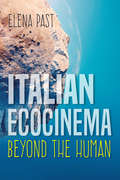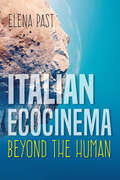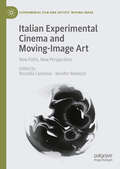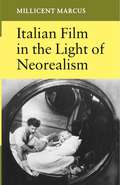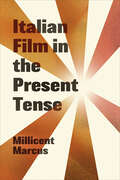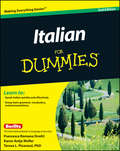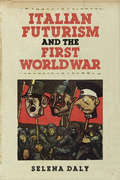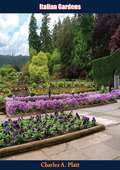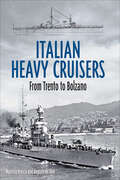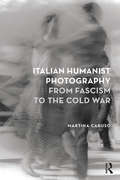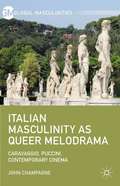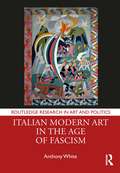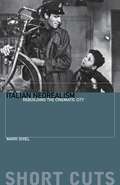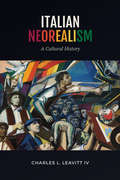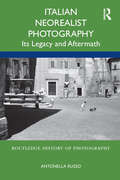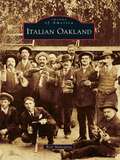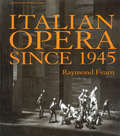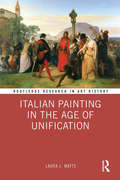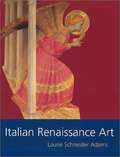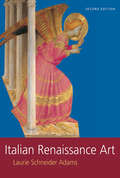- Table View
- List View
Italian Ecocinema Beyond the Human (New Directions in National Cinemas)
by Elena PastEntangled in the hybrid fields of ecomedia studies and material ecocriticism, Elena Past examines five Italian films shot on location and ponders the complex relationships that the production crews developed with the filming locations and the nonhuman cast members. She uses these films—Red Desert (1964), The Winds Blows Round (2005), Gomorrah (2008), Le quattro volte (2010), and Return to the Aeolian Islands (2010)—as case studies to explore pressing enviornmental questions such as cinema's dependence on hydrocarbons, the toxic waste crisis in the region of Campania, and our reliance on the nonhuman world. Dynamic and unexpected actors emerge as the subjects of each chapter: playful goats, erupting volcanoes, airborne dust particles, fluid petroleum, and even the sound of silence. Based on interviews with crew members and close readings of the films themselves, Italian Ecocinema Beyond the Human theorizes how filmmaking practice—from sound recording to location scouting to managing a production—helps uncover cinema's ecological footprint and its potential to open new perspectives on the nonhuman world.
Italian Ecocinema: Beyond the Human (New Directions in National Cinemas)
by Elena PastEcocriticism and film studies unite in this examination of five Italian films and the environmental questions they raise.Entangled in the hybrid fields of ecomedia studies and material ecocriticism, Elena Past examines five Italian films shot on location and ponders the complex relationships that the production crews developed with the filming locations and the nonhuman cast members. She uses these films—Red Desert (1964), The Winds Blows Round (2005), Gomorrah (2008), Le quattro volte (2010), and Return to the Aeolian Islands (2010)—as case studies to explore pressing environmental questions such as cinema’s dependence on hydrocarbons, the toxic waste crisis in the region of Campania, and our reliance on the nonhuman world. Dynamic and unexpected actors emerge as the subjects of each chapter: playful goats, erupting volcanoes, airborne dust particles, fluid petroleum, and even the sound of silence. Based on interviews with crew members and close readings of the films themselves, Italian Ecocinema Beyond the Human theorizes how filmmaking practice—from sound recording to location scouting to managing a production—helps uncover cinema’s ecological footprint and its potential to open new perspectives on the nonhuman world.“[Past] uniquely and innovatively combines film studies and material ecocriticism with a focus on Italy. Such weaving of tales brings the films to life and reads them as ecological documents and Italian stories.” —Heather I. Sullivan, author of The Intercontextuality of Self and Nature in Ludwig Tieck’s Early Works“A timely and incisive study that interrogates a new, though growing, trend in film criticism and makes an important and rich contribution to Italian film studies, Italian cultural studies, and ecocriticism.” —Bernadette Luciano, author (with Susanna Scarparo) of Reframing Italy: New Trends in Italian Women’s Filmmaking“Part memoir, part close analysis of the films themselves, and illustrated with numerous excellent frame grabs, Past’s book casts a dreamlike spell as it contemplates the past, present, and future of the cinema and moves smoothly between environmental issues and aesthetic and practical concerns.” —Choice
Italian Ecocinema: Beyond the Human (New Directions in National Cinemas)
by Elena PastEcocriticism and film studies unite in this examination of five Italian films and the environmental questions they raise.Entangled in the hybrid fields of ecomedia studies and material ecocriticism, Elena Past examines five Italian films shot on location and ponders the complex relationships that the production crews developed with the filming locations and the nonhuman cast members. She uses these films—Red Desert (1964), The Winds Blows Round (2005), Gomorrah (2008), Le quattro volte (2010), and Return to the Aeolian Islands (2010)—as case studies to explore pressing environmental questions such as cinema’s dependence on hydrocarbons, the toxic waste crisis in the region of Campania, and our reliance on the nonhuman world. Dynamic and unexpected actors emerge as the subjects of each chapter: playful goats, erupting volcanoes, airborne dust particles, fluid petroleum, and even the sound of silence. Based on interviews with crew members and close readings of the films themselves, Italian Ecocinema Beyond the Human theorizes how filmmaking practice—from sound recording to location scouting to managing a production—helps uncover cinema’s ecological footprint and its potential to open new perspectives on the nonhuman world.“[Past] uniquely and innovatively combines film studies and material ecocriticism with a focus on Italy. Such weaving of tales brings the films to life and reads them as ecological documents and Italian stories.” —Heather I. Sullivan, author of The Intercontextuality of Self and Nature in Ludwig Tieck’s Early Works“A timely and incisive study that interrogates a new, though growing, trend in film criticism and makes an important and rich contribution to Italian film studies, Italian cultural studies, and ecocriticism.” —Bernadette Luciano, author (with Susanna Scarparo) of Reframing Italy: New Trends in Italian Women’s Filmmaking“Part memoir, part close analysis of the films themselves, and illustrated with numerous excellent frame grabs, Past’s book casts a dreamlike spell as it contemplates the past, present, and future of the cinema and moves smoothly between environmental issues and aesthetic and practical concerns.” —Choice
Italian Experimental Cinema and Moving-Image Art: New Paths, New Perspectives (Experimental Film and Artists’ Moving Image)
by Rossella Catanese Jennifer MalvezziThis volume presents one of the first systematic inquiries into Italian experimental and avant-garde cinema in English language, thanks to contributions which deepen the history of experimental audio-visual works in Italy. Frameworks of film production, distribution and circulation, as well as theoretical discourses and emblematic case studies are investigated by this edited collection, which tries to provide a broad overview of the complex phenomena that occurred in a century of cinema beyond its industry, its market, and its conventions. The aim of this book is not to offer a comprehensive compendium, but to explore new paths in researching Italian experimental moving image, its history, and new theoretical insights into authors and their works. The volume is structured in thematic sections. Each of them includes different contributions according to two different types: plenary essays, which offer in-depth analyses on historical and theoretical features, and monographic essays, which focus on single authors, collectives, or works.
Italian Film in the Light of Neorealism
by Millicent MarcusThe movement known as neorealism lasted seven years, generated only twenty-one films, failed at the box office, and fell short of its didactic and aesthetic aspirations. Yet it exerted such a profound influence on Italian cinema that all the best postwar directors had to come to terms with it, whether in seeming imitation (the early Olmi), in commercial exploitation (the middle Comencini) or in ostensible rejection (the recent Tavianis). Despite the reactionary pressures of the marketplace and the highly personalized visions of Fellini, Antonioni. And Visconti, Italian cinema has maintained its moral commitment to use the medium in socially responsible ways--if not to change the world, as the first neorealists hoped, then at least to move filmgoers to face the pressing economic, political, and human problems in their midst. From Rossellini's Open City (1945) to the Taviani brothers' Night of the Shooting Stars (1982). The author does close readings of seventeen films that tell the story of neorealism's evolving influence on Italian postwar cinematic expression.Other films discussed are De Sica's Bicycle Thief and Umberto D. De Santis's Bitter Rice, Comencini's Bread, Love, and Fantasy, Fellini's La strada, Visconti's Senso, Antonioni's Red Desert, Olmi's Il Posto, Germi's Seduced and Abandoned, Pasolini's Teorema, Petri's Investigation of a Citizen above Suspicion, Bertolucci's The Conformist, Rosi's Christ Stopped at Eboli, and Wertmuller's Love and Anarchy, Scola's We All Loved Each Other So Much provides the occasion for the author's own retrospective consideration of how Italian cinema has fulfilled, or disappointed, the promise of neorealism.
Italian Film in the Present Tense (Toronto Italian Studies)
by Millicent MarcusFor observers of the European film scene, Federico Fellini’s death in 1993 came to stand for the demise of Italian cinema as a whole. Exploring an eclectic sampling of works from the new millennium, Italian Film in the Present Tense confronts this narrative of decline with strong evidence to the contrary. Millicent Marcus highlights Italian cinema’s new sources of industrial strength, its re-placement of the Rome-centred studio system with regional film commissions, its contemporary breakthroughs on the aesthetic front, and its vital engagement with the changing economic and socio-political circumstances in twenty-first-century Italian life. Examining works that stand out for their formal brilliance and their moral urgency, the book presents a series of fourteen case studies, featuring analyses of such renowned films as Il Divo, Gomorrah, The Great Beauty, We Have a Pope, The Mafia Only Kills in the Summer, and Fire at Sea, along with lesser-known works deserving of serious critical scrutiny. In doing so, Italian Film in the Present Tense contests the widely held perception of a medium languishing in its "post-Fellini" moment, and instead acknowledges the ethical persistence and forward-looking currents of Italian cinema in the present tense.
Italian For Dummies
by Francesca Romana Onofri Karen Antje Möller Teresa L. PicarazziThe fun and easy way to take your Italian language skills to the next level The tips, techniques, and information presented here give students, travelers, and businesspeople a primer on how to speak Italian. Complete with updates, a bonus CD, and the traditional For Dummies user-friendly format, this new edition of Italian For Dummies gives you reliable lessons, practice, and language learning techniques for speaking Italian with ease and confidence. Featuring a revamped, user-friendly organization that builds on your knowledge and ability, Italian For Dummies offers expanded coverage of the necessary grammar, major verb tenses, and conjugations that beginners need to know. Plus, you'll get a fully updated and expanded audio CD that includes real-life conversations; a refreshed and expanded mini-dictionary; more useful exercises and practice opportunities; and more. Builds on your skills and ability as you learn Covers the grammar, verb tenses, and conjugations you need to know Includes a mini-dictionary Audio CD includes real-life conversations If you're looking to reach a comfort level in conversational Italian, Italian For Dummies gets you comfortably speaking this Romantic language like a native.
Italian Forgers: The Art Market and the Weight of the Past in Modern Italy
by Carol HelstoskyItalian Forgers takes an unorthodox approach to the fascinating topic of art forgery, focusing not on art forgery per se, but on the major forgery scandals that shifted the Italian art market in response to constant, and often intense, demand for Italian objects. By focusing on power dynamics that both precipitated forgery scandals and forged Italian cultural identities, this book connects the debates and discussions about three well-known Italian forgers—Giovanni Bastianini, Icilio Joni, and Alceo Dossena—to anchor and investigate the mechanics of the Italian art market from unification through the fascist era.Carol Helstosky examines foreign accounts of transactions and Italian writings about the art market. The actions and words of Italian dealers illustrate how the Italian art and antiquities market was an undeniably modern industry, on par with tourism in terms of its contribution to the Italian economy and to understandings of Italian identity. These accounts also reveal how dealers, artists, go-betweens, guides, and restorers worked to not only meet the intense demand for Italian products but also to develop highly sophisticated business practices to maintain financial stability and respond to shifts in demand consciously (but not always conscientiously).Italian Forgers weaves a compelling narrative about the history of Italian identity, forgery, and the value of the past. As a result, Helstosky brings historical perspective to the study of art forgery and art fraud. She reveals how historical circumstances and structural imbalances of cultural power shaped the market for art and antiquities and amplified incidents of art deception and forgery scandals.
Italian Futurism and the First World War
by Selena DalySelena Daly's work is the first comprehensive study of Futurism during the First World War period. In this book, she examines the cultural, political, and military engagement of the Futurists with the war effort, both on the battlefields and on the home front. Beginning with the outbreak of war in 1914, Italian Futurism and the First World War provides vivid accounts of Futurist experiences through an analysis of previously unpublished material, including letters, diaries, and military documents as well as newspapers, magazines, and popular novels. Her focus on Futurist protagonists such as Filippo Tommaso Marinetti, Umberto Boccioni, Emilio Settimelli, and lesser known figures such as Giuseppe Steiner and Ennio Valentinelli greatly extends our knowledge of the movement. Daly's timely and detailed analysis challenges long-held assumptions about Futurist activity during the war and offers new insights for both the non-specialist and specialist alike.
Italian Gardens
by Charles A. Platt“The first steps of one interested in the formal style of landscape architecture should be directed to Italy.” So wrote the great American designer Charles Platt in his introduction to his book, Italian Gardens, first published in 1894. Platt's words proved influential.Devoted solely to the topic of the Italian villa landscape, the handsomely illustrated volume quickly found an eager readership among American architects, landscape designers, and their clients. As the first publication in English on the topic, Italian Gardens appealed to a public increasingly intrigued by the question of what the new American garden might look like.Platt's book also turned a national spotlight on his own fledgling architectural career, transforming him into one of the most sought-after designers in the country. Perhaps no volume in the history of American landscape architecture has had so far-reaching an effect.The book offered far more than just specific design motifs to gardeners and architects. Elegant photographs painted a picture of a celebratory indoor/outdoor lifestyle. The text indirectly prescribed a specific relationship between the residential landscape and architecture. Platt saw the genius in the Italian concept of a garden as a series of rooms, or apartments, “where one,” he reported, “might walk about and find a place suitable to the hour of the day and feeling of the moment, and still be in that sacred portion of the globe dedicated to one's self.” American designers took Platt's observations and images to heart, and made extensive use of them.-Print ed.
Italian Heavy Cruisers: From Trento to Bolzano
by Maurizio Brescia Augusto de ToroA technical history of seven Italian heavy cruisers: Trento, Trieste, Bolzano, Zara, Fiume, Gorizia, Pola—a perfect companion volume to Italian Battleships.When the Washington Naval Treaty of 1922 effectively banned the building of battleships, competition between the major navies concentrated on the next most powerful category, heavy cruisers limited to ten thousand tons displacement and eight-inch guns. Italy followed this trend, the first design for what became Trento and Trieste being ordered in 1924. These were the fastest of the first generation ‘Treaty’ cruisers but were very lightly armored, and the succeeding Zara class of four ships were slower but better protected. However, before the final ship of this class (Pola) had been completed, there was a return to the earlier fast, lightly protected concept with the Bolzano, although this ship also incorporated aspects of the Zara design. The political background, design history and technical features of these classes are covered in great depth in this volume. They were important ships, subject to incremental improvement so no two were identical, and model makers will appreciate the space devoted to the variations in appearance, using both description and illustration. As major units of the Italian battle fleet, they were more active than most during the war and their careers are fully detailed, including analyses of damage suffered. Tragically, they were all sunk, and the circumstance of each loss is explored. As befits a technical history, the book is thoroughly illustrated with ship and armament plans, detail drawings and color camouflage schemes, as well as an outstanding collection of photographs.
Italian Humanist Photography from Fascism to the Cold War
by Martina CarusoSpanning four decades of radical political and social change in Italy, this interdisciplinary study explores photography’s relationship with Italian painting, film, literature, anthropological research and international photography. Evocative and powerful, Italian social documentary photography from the 1930s to the 1960s is a rich source of cultural history, reflecting a time of dramatic change. This book shows, through a wide range of images (some published for the first time) that to fully understand the photography of this period we must take a more expansive view than scholars have applied to date, considering issues of propaganda, aesthetics, religion, national identity and international influences. By setting Italian photography against a backdrop of social documentary and giving it a distinctive place in the global history of photography, this exciting volume of original research is of interest to art historians and scholars of Italian and visual culture studies.
Italian Masculinity as Queer Melodrama
by John ChampagneOffering queer analyses of paintings by Caravaggio and Puccini and films by #65533;zpetek, Amelio, and Grimaldi, Champagne argues that Italian masculinity has often been articulated through melodrama. Wide in scope and multidisciplinary in approach, this much-needed study shows the vital role of affect for both Italian history and masculinity studies.
Italian Modern Art in the Age of Fascism (Routledge Research in Art and Politics)
by Anthony WhiteThis book examines the work of several modern artists, including Fortunato Depero, Scipione, and Mario Radice, who were working in Italy during the time of Benito Mussolini’s rise and fall. It provides a new history of the relationship between modern art and fascism. The study begins from the premise that Italian artists belonging to avant-garde art movements, such as futurism, expressionism, and abstraction, could produce works that were perfectly amenable to the ideologies of Mussolini’s regime. A particular focus of the book is the precise relationship between ideas of history and modernity encountered in the art and politics of the time and how compatible these truly were.
Italian Neorealism
by Mark ShielItalian Neorealism: Rebuilding the Cinematic City is a valuable introduction to one of the most influential of film movements. Exploring the roots and causes of neorealism, particularly the effects of the Second World War, as well as its politics and style, Mark Shiel examines the portrayal of the city and the legacy left by filmmakers such as Rossellini, De Sica, and Visconti. Films studied include Rome, Open City (1945), Paisan (1946), The Bicycle Thief (1948), and Umberto D. (1952).
Italian Neorealism: A Cultural History (Toronto Italian Studies)
by Charles L. Leavitt IVNeorealism emerged as a cultural exchange and a field of discourse that served to shift the confines of creativity and revise the terms of artistic expression not only in Italy but worldwide. If neorealism was thus a global phenomenon, it is because of its revolutionary portrayal of a transformative moment in the local, regional, and national histories of Italy. At once guiding and guided by that transformative moment, neorealist texts took up, reflected, and performed the contentious conditions of their creation, not just at the level of narrative content but also in their form, language, and structure. Italian Neorealism: A Cultural History demonstrates how they did so through a series of representative case studies. Recounting the history of a generation of artists, this study offers fundamental insights into one of the most innovative and influential cultural moments of the twentieth century.
Italian Neorealism: Rebuilding the Cinematic City (Short Cuts)
by Mark ShielItalian Neorealism: Rebuilding the Cinematic City is a valuable introduction to one of the most influential of film movements. Exploring the roots and causes of neorealism, particularly the effects of the Second World War, as well as its politics and style, Mark Shiel examines the portrayal of the city and the legacy left by filmmakers such as Rossellini, De Sica, and Visconti. Films studied include Rome, Open City (1945), Paisan (1946), The Bicycle Thief (1948), and Umberto D. (1952).
Italian Neorealist Cinema
by Christopher WagstaffThe end of the Second World War saw the emergence of neorealist film in Italy. In Italian Neorealist Cinema, Christopher Wagstaff analyses three neorealist films that have had significant influence on filmmakers around the world. Wagstaff treats these films as assemblies of sounds and images rather than as representations of historical reality. If Roberto Rossellini's Roma città aperta and Paisà, and Vittorio De Sica's Ladri di biciclette are still, half a century after they were made, among the most highly valued artefacts in the history of cinema, Wagstaff suggests that this could be due to the aesthetic and rhetorical qualities of their assembled narratives, performances, locations, lighting, sound, mise en scène, and montage.This volume begins by situating neorealist cinema in its historical, industrial, commercial and cultural context, and makes available for the first time a large amount of data on post-war Italian cinema. Wagstaff offers a theoretical discussion of what it means to treat realist films as aesthetic artefacts before moving on to the core of the book, which consists of three studies of the films under discussion. Italian Neorealist Cinema not only offers readers in Film Studies and Italian Studies a radically new perspective on neorealist cinema and the Italian art cinema that followed it, but theorises and applies a method of close analysis of film texts for those interested in aesthetics and rhetoric, as well as cinema in general.
Italian Neorealist Photography: Its Legacy and Aftermath (Routledge History of Photography)
by Antonella RussoThis book offers an analysis of the socio-historical conditions of the rise of postwar Italian photography, considers its practices, and outlines its destiny. Antonella Russo provides an incisive examination of Neorealist photography, delineates its periodization, traces its instances and its progressive popularization and subsequent co-optation that occurred with the advent of the industrialization of photographic magazines. This volume examines the ethno(photo)graphic missions of Ernesto De Martino in the deep South of Italy, the key role played by the Neorealist writer and painter Carlo Levi as "ambassador of international photography", and the journeys of David Seymour, Henry Cartier Bresson, and Paul Strand in Neorealist Italy. The text includes an account the formation and proliferation of Italian photographic associations and their role in institutionalizing and promoting Italian photography, their link to British and other European photographic societies, and the subsequent decline of Neorealism. It also considers the inception of non-objective photography that thrived soon after the war, in concurrence with the circulation of Neorealism, thus debunking the myth identifying all Italian postwar photography with the Neorealist image. This book will be particularly useful for scholars and students in the history and theory of photography, and Italian history.
Italian Oakland (Images of America)
by Rick MalaspinaOakland, the other city by the bay, was a magnet for Italian immigrants in the early decades of the 20th century. Some relocated from San Francisco after the devastating 1906 earthquake and fire; many more came to Oakland predominantly from Italy's northern regions of Piedmont, Liguria, and Lombardy in search of opportunity and prosperity. These pioneers worked hard, typically at backbreaking labor, to build new lives. They raised a generation of children who succeeded in their own right and contributed in various ways to their community and nation. As they established new roots and adopted new ways, congregating largely in north Oakland's vibrant and bustling Temescal neighborhood, these Italian Americans also nurtured their Old Country customs and traditions--many of which, along with rare glimpses of bygone days, are portrayed in this charming trip through time.
Italian Opera Since 1945 (Contemporary Music Studies #Vol. 15)
by Raymond FearnFirst Published in 1998. Routledge is an imprint of Taylor & Francis, an informa company.
Italian Painting in the Age of Unification (Routledge Research in Art History)
by Laura L. WattsItalian Painting in the Age of Unification reconstructs the artistic motivations and messaging of three artists—Tommaso Minardi, Francesco Hayez, and Gioacchino Toma—from three distinct regions in Italy prior to, during, and directly following political unification in 1861. Each artist, working in Rome, Milan, and Naples, respectively, adopted the visual narratives particular to his region, using style to communicate aspects of his political, religious, or social context. By focusing on these three figures, this study will introduce readers outside of Italy to their diversity of practice, and provide a means for understanding their place within the larger field of international nineteenth-century art, albeit a place largely distinct from the better-known French tradition. The book will be of interest to scholars working in art history, nationalism, Italian history, or Italian studies.
Italian Political Cinema: Figures of the Long ’68
by Mauro ResminiAn exploration of how film has made legible the Italian long &’68 as a moment of crisis and transitionTraditionally, the definition of political cinema assumes a relationship between cinema and politics. In contrast to this view, author Mauro Resmini sees this relationship as an impasse. To illustrate this theory, Resmini turns to Italian cinema to explore how films have reinvented the link between popular art and radical politics in Italy from 1968 to the early 1980s, a period of intense political and cultural struggles also known as the long &’68.Italian Political Cinema conjures a multifaceted, complex portrayal of Italian society. Centered on emblematic figures in Italian cinema, it maps the currents of antagonism and repression that defined this period in the country&’s history. Resmini explores how film imagined the possibilities, obstacles, and pitfalls that characterized the Italian long &’68 as a moment of crisis and transition. From workerism to autonomist Marxism to feminism, this book further expands the debate on political cinema with a critical interpretation of influential texts, some of which are currently only available in Italian.A comprehensive and novel redefinition of political film, Italian Political Cinema introduces its audience to lesser-known directors alongside greats such as Pasolini, Bertolucci, Antonioni, and Bellocchio. Resmini offers access to untranslated work in Italian philosophy, political theory, and film theory, and forcefully advocates for the continued artistic and political relevance of these films in our time.
Italian Renaissance Art
by Laurie Schneider AdamsArt historian Laurie Schneider Adams brings to students a vibrant and engaging presentation of Renaissance art history that is supported by up-to-date scholarship and methodology. The text opens with the late Byzantine work of Cimabue and concludes with the transition to Mannerism. The author's focus is on the most important and innovative artists and their principal works, with a clear emphasis on selectivity and understanding. Italian Renaissance Art also focuses on style and iconography, and on art and artists, incorporating different methodological approaches to create a wider understanding and appreciation of the art. Distinguishing features of this text include: Over 400 illustrations, with 215 in full color, are integrated with the text, and large enough to properly view. In depth coverage on the most important and innovative artists and their principle works throughout Italy. Side boxes that provide additional material on techniques, biographical data, descriptions of artistic media, as well as necessary background information are used in every chapter. "Controversy" boxes introduce some of the ongoing scholarly quarrels among Renaissance art historians. Maps, plans, and diagrams are also included throughout. A historical chronology, a full glossary of art-historical terms, and a select bibliography are also included at the end of the text.
Italian Renaissance Art
by Laurie Schneider Adams"The chronology of the Italian Renaissance, its character, and context have long been a topic of discussion among scholars. Some date its beginnings to the fourteenthcentury work of Giotto, others to the generation of Masaccio, Brunelleschi, and Donatello that fl ourished from around 1400. The close of the Renaissance has also proved elusive. Mannerism, for example, is variously considered to be an independent (but subsidiary) late aspect of Renaissance style or a distinct style in its own right."
